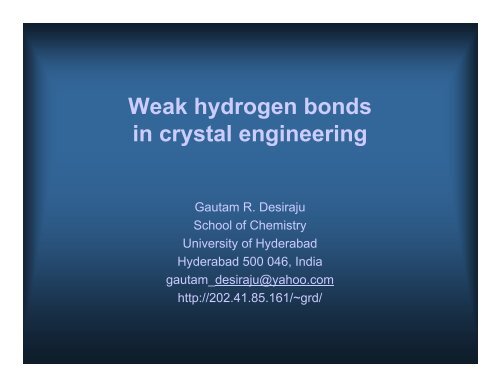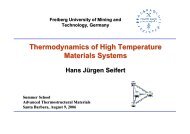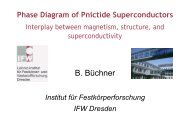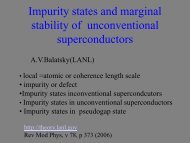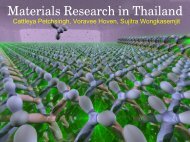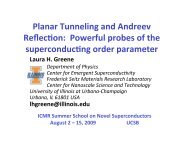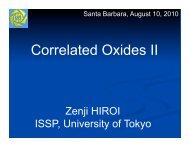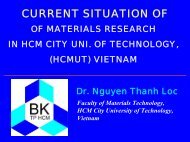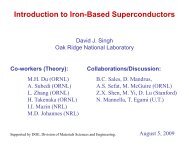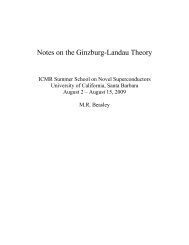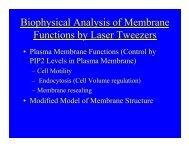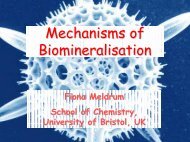Weak hydrogen bonds in crystal engineering
Weak hydrogen bonds in crystal engineering
Weak hydrogen bonds in crystal engineering
Create successful ePaper yourself
Turn your PDF publications into a flip-book with our unique Google optimized e-Paper software.
<strong>Weak</strong> <strong>hydrogen</strong> <strong>bonds</strong><br />
<strong>in</strong> <strong>crystal</strong> eng<strong>in</strong>eer<strong>in</strong>g<br />
Gautam R. Desiraju<br />
School of Chemistry<br />
University of Hyderabad<br />
Hyderabad 500 046, India<br />
gautam_desiraju@yahoo.com<br />
http://202.41.85.161/~grd/
What is <strong>crystal</strong> eng<strong>in</strong>eer<strong>in</strong>g?<br />
The understand<strong>in</strong>g of <strong>in</strong>termolecular <strong>in</strong>teractions<br />
<strong>in</strong> the context of <strong>crystal</strong> pack<strong>in</strong>g and <strong>in</strong> the<br />
utilisation of such understand<strong>in</strong>g <strong>in</strong> the design of<br />
new solids with desired physical and chemical<br />
properties.<br />
Crystal Eng<strong>in</strong>eer<strong>in</strong>g: The Design of Organic Solids,<br />
Elsevier, Amsterdam, 1989
Crystal eng<strong>in</strong>eer<strong>in</strong>g<br />
The practical question<br />
Given the molecular structure of an organic<br />
compound what is its <strong>crystal</strong> structure?
The problem<br />
• Intermolecular <strong>in</strong>teractions <strong>in</strong> organic molecular solids are weak<br />
• A functional group forms <strong>in</strong>teractions with other groups but its<br />
exact behaviour dur<strong>in</strong>g <strong>crystal</strong>lisation depends on the nature<br />
and position<strong>in</strong>g of all the other functional groups <strong>in</strong> the molecule<br />
– In supramolecular chemistry, hydrocarbon residues also<br />
count as functional groups.<br />
• Therefore <strong>crystal</strong> structures are not related to molecular<br />
structures <strong>in</strong> simple ways<br />
• The goal is to f<strong>in</strong>d families of <strong>crystal</strong> structures that are related<br />
to the molecular structures <strong>in</strong> simple, easily understandable<br />
ways, based on well known chemical pr<strong>in</strong>ciples
How would we expect molecular and <strong>crystal</strong><br />
structures to be related?<br />
Could we relate molecular and <strong>crystal</strong> structure through<br />
structural units of an <strong>in</strong>termediate size?<br />
These units would need to be simple enough that they<br />
are understood <strong>in</strong> terms of the most favoured<br />
<strong>in</strong>termolecular <strong>in</strong>teractions possible for the molecule, but<br />
complex enough that they represent core features of the<br />
<strong>crystal</strong> pack<strong>in</strong>g.<br />
Such units would have k<strong>in</strong>etic significance
Supramolecular synthons<br />
are structural units with<strong>in</strong><br />
supermolecules which<br />
can be formed and/or<br />
assembled by known or<br />
conceivable synthetic<br />
operations <strong>in</strong>volv<strong>in</strong>g<br />
<strong>in</strong>termolecular <strong>in</strong>teractions<br />
Desiraju (1995)
What synthons are possible?<br />
O<br />
H<br />
O<br />
O<br />
H<br />
O<br />
H<br />
O<br />
O<br />
H
C–H···N Hydrogen Bonds<br />
L<strong>in</strong>ear Motifs and Structural Insulation<br />
···N≡C–H···N≡C–H···N≡C–H···<br />
Dulmage and Lipscomb, Acta Cryst., 4, 330, 1951<br />
···N≡C–C≡C–H···N≡C–C≡C–H···N≡C–C≡C–H···<br />
Shallcross and Carpenter, Acta Cryst, 11, 490, 1958<br />
N<br />
H<br />
N<br />
H<br />
Thaimattam et al, New. J. Chem., 1307, 1998
Synthon hierarchy<br />
O<br />
H<br />
O<br />
O<br />
H<br />
O<br />
N<br />
H<br />
H<br />
N<br />
O<br />
O<br />
H<br />
N<br />
H
Structural <strong>in</strong>sulation<br />
H<br />
O<br />
O<br />
H<br />
O<br />
O<br />
H<br />
O<br />
O<br />
O<br />
O<br />
H<br />
O<br />
O<br />
H<br />
O<br />
O<br />
H<br />
O<br />
N<br />
O<br />
H<br />
N<br />
H<br />
H<br />
H<br />
H<br />
H<br />
O<br />
N<br />
O<br />
H<br />
N<br />
H<br />
H<br />
H<br />
H<br />
H<br />
O<br />
N<br />
O<br />
H<br />
N<br />
H<br />
H<br />
H<br />
H<br />
H<br />
O<br />
N<br />
O<br />
H<br />
N<br />
H<br />
H<br />
H<br />
H<br />
H<br />
O<br />
N<br />
O<br />
O<br />
O<br />
H<br />
H<br />
O<br />
O<br />
H<br />
N<br />
H<br />
H<br />
H<br />
H<br />
H<br />
O<br />
N<br />
O<br />
O<br />
O<br />
H<br />
H<br />
O<br />
O<br />
H<br />
N<br />
H<br />
H<br />
H<br />
H<br />
H<br />
C.V.K. Sharma et al., J. Chem. Soc., Chem. Commun.,832, 1992
Multipo<strong>in</strong>t recognition<br />
H<br />
N<br />
N<br />
N<br />
H<br />
H<br />
O<br />
H<br />
H<br />
O<br />
H<br />
N<br />
H<br />
O<br />
O<br />
O<br />
N<br />
H<br />
O<br />
N<br />
O<br />
O<br />
N<br />
O<br />
K. Biradha et al., J. Chem. Soc., Chem. Commun.,1473, 1993
Interaction <strong>in</strong>terference<br />
Danazole<br />
OH<br />
H<br />
N<br />
O<br />
Expected<br />
O–H…O–H…O–H…<br />
Found<br />
O–H…π and C–H…O<br />
M. A. Viswamitra et al., J. Am. Chem. Soc., 115, 4868, 1993
A functional <strong>crystal</strong><br />
O 2<br />
N<br />
H<br />
NO 2<br />
Br<br />
NO 2<br />
Br<br />
Space group C2<br />
(302)<br />
2.60Å, 155.2°<br />
Intense powder<br />
SHG signal at<br />
1.06 µm<br />
P. K. Thallapally et al., Chem. Commun., 1052, 2002
Reversible host framework<br />
deformation
syn-anti Catemer <strong>in</strong> 4-chlorocubanecarboxylic acid<br />
Supportive C–H···O bond<br />
Kuduva et al, JACS, 121, 1936, 1999
What do carboxylic acids do <strong>in</strong> the solid state?<br />
O<br />
H<br />
O<br />
O H O<br />
Dimer<br />
O<br />
O<br />
H<br />
O<br />
O H O<br />
O H O<br />
O H<br />
syn-Catemer<br />
O<br />
O<br />
O<br />
O<br />
H<br />
H<br />
syn,anti-Catemer
Different molecules, same <strong>crystal</strong> structure<br />
Two times lucky<br />
Cl<br />
CO 2<br />
H<br />
H<br />
Cl<br />
CO 2<br />
H<br />
H<br />
K. V. R. Kishan et al., Chem. Mater., 2, 447, 1990
Superposition of the two structures
Lucky aga<strong>in</strong><br />
R<br />
CO 2<br />
H<br />
R<br />
CO 2<br />
H<br />
H<br />
H<br />
pK a ~ 38 pK a ~ 44<br />
Gives a chance to probe stereoelectronic effects
Hypotheses<br />
Catemer formation requires two structural features: a sufficiently<br />
activated C–H group and a ballast group at the other end of the<br />
molecule that provides stabilization via close pack<strong>in</strong>g<br />
For the cubane acids, the R-group only needs to provide steric bulk<br />
For the phenylpropiolic acids, the R-group needs to provide both<br />
steric bulk and electronic activation
Stereoelectronic effects <strong>in</strong> the solid state<br />
COOH<br />
COOH<br />
R<br />
H<br />
R<br />
H<br />
R = H, F, Cl, Br, I, CH 3<br />
D. Das et al, Crystal Growth & Design, 3, 675, 2003
4-substituent Cubane Phenylpropiolic<br />
H Dimer Dimer<br />
F Dimer Catemer<br />
Cl Catemer Catemer<br />
Br Catemer Catemer<br />
I Catemer Catemer<br />
CH 3<br />
Catemer Dimer
Hydrogen bond<br />
The master-key of molecular recognition<br />
Strength<br />
Directionality<br />
<strong>Weak</strong>ness<br />
Flexibility
Strong or weak?<br />
Anti-cooperative synthon <strong>in</strong><br />
Cytochrome Cd1 nitrite reductase / Heme D/ Heme C<br />
C−H···O (2.55 Å)<br />
N−H···O (2.22 Å)<br />
(PDB ID: 1QKS)<br />
S. Sarkhel and G. R. Desiraju, Prote<strong>in</strong>s, 54, 247, 2004
C–H…O Hydrogen Bonds <strong>in</strong> the Nuclear Receptor RARγ<br />
Specificity<br />
Aff<strong>in</strong>ity<br />
Reversibility<br />
Hydrophobicity<br />
Klaholz and Moras, Structure, 10, 1197-1204, 2002
EGFR K<strong>in</strong>ase Inhibitor<br />
Lys721<br />
Val702<br />
Hydrophobic pocket<br />
Met742<br />
Leu764<br />
Prote<strong>in</strong> cleft<br />
O<br />
O<br />
O<br />
O<br />
(6)<br />
(7)<br />
HN<br />
N(3)<br />
N(1)<br />
H<br />
1.81 2.19<br />
H<br />
2.01<br />
H<br />
O<br />
Water10<br />
2.40<br />
H O<br />
Thr766<br />
O<br />
N<br />
H<br />
N<br />
O<br />
Gln767<br />
Met769<br />
V. Aparna et al., J. Chem. Inf. Model., 45, 725, 2005
Conclusions<br />
The C–H…O and other ‘weak’ <strong>hydrogen</strong> <strong>bonds</strong> are<br />
specific <strong>in</strong>teractions with<br />
dist<strong>in</strong>ct structural consequences<br />
Many C–H…O <strong>bonds</strong> may be considered to be<br />
structure determ<strong>in</strong><strong>in</strong>g<br />
Presence or absence of a s<strong>in</strong>gle weak <strong>in</strong>teraction<br />
may result <strong>in</strong> a cascade of changes<br />
Different weak <strong>in</strong>teractions may be of vary<strong>in</strong>g<br />
importance <strong>in</strong> determ<strong>in</strong><strong>in</strong>g <strong>crystal</strong> pack<strong>in</strong>g
•Students and post-doctorals<br />
•Judith Howard, Roland Boese<br />
•University of Hyderabad<br />
•Department of Science and Technology<br />
•Council of Scientific and Industrial Research<br />
•Defense Research and Development Organisation<br />
•Miguel Garcia-Garibay


